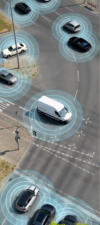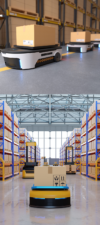The future of autonomous transport systems (ATS) in industry
Autonomous transport systems (ATS) are at the centre of a revolutionary development that could fundamentally change industrial logistics and production. This technology promises not only a significant increase in efficiency and productivity, but also improved safety and flexibility in various application areas. This in-depth article takes a detailed look at the current applications, technological developments, potential challenges and future potential of autonomous transport systems in industry.
Autonomous transport systems (ATS) are at the centre of a revolutionary development that could fundamentally change industrial logistics and production. This technology promises not only a significant increase in efficiency and productivity, but also improved safety and flexibility in various application areas. This in-depth article takes a detailed look at the current applications, technological developments, potential challenges and future potential of autonomous transport systems in industry.
1. Introduction to Autonomous Transport Systems (ATS)
Autonomous transport systems are vehicles or robotic systems that can operate without direct human control or intervention. They use advanced sensors, artificial intelligence (AI) and precise navigation algorithms to analyze their environment, make decisions and autonomously perform tasks such as material transport, goods movement and warehouse management. ATS are part of the digital transformation in industry, which aims to make processes more efficient, flexible and intelligent.
2. Current applications of autonomous transport systems
2.1 Intralogistics and factory automation
In the manufacturing industry, ATS are increasingly being used in intralogistics to optimize the flow of materials between different production stages. They take over routine activities such as the transport of raw materials, semi-finished products and finished products within the factory halls. This leads to a reduction in lead times, inventory levels and operating costs.
2.2 Warehousing and distribution centers
In large warehouses and distribution centers, autonomous transport systems support efficient inventory management and order picking. They can automatically transport goods from shelf to shelf, monitor stocks and perform inventory counts, increasing accuracy and minimizing human error.
2.3 Transport in public spaces and logistics
In the field of public transportation and logistics, autonomous vehicles are increasingly being viewed as an alternative to traditional modes of transportation. This includes the use of autonomous delivery vans for last-mile delivery and the integration of autonomous trucks into long-haul logistics to increase supply chain efficiency and reduce traffic congestion.
3. Technological developments and innovations
3.1 Advances in sensor technology
The use of sophisticated sensors such as lidar, radar and camera systems enables autonomous transport systems to accurately perceive their surroundings and detect obstacles in real time. These sensors play a crucial role in the safety and performance of autonomous vehicles in dynamic environments.
3.2 Artificial intelligence and machine learning
AI algorithms help ATS make decisions and plan routes based on real-time and historical information. Machine learning enables systems to learn from experience and continuously improve their performance by adapting to changing conditions.
3.3 Networking and IoT integration
The integration of Internet of Things (IoT) technologies enables seamless communication between autonomous vehicles, infrastructure elements and other production facilities. This promotes coordination and collaboration across the entire manufacturing environment and optimizes operational processes.
4. Challenges and concerns
Despite the promising benefits and technological advances, autonomous transport systems face a number of challenges:
4.1 Legal and regulatory framework
The development and introduction of autonomous vehicles requires clear legal and regulatory guidelines for approval, liability and operation. Different legal regulations in different regions make it difficult to introduce and use the technology in a uniform manner.
4.2 Security and data protection
The security of autonomous transport systems is a key issue that is being discussed intensively. Robust security measures must be implemented to prevent cyberattacks and ensure the integrity of the systems. At the same time, data protection guidelines must be adhered to in order to protect the privacy of users.
4.3 Technological complexity and costs
Developing and implementing cutting-edge sensors, AI algorithms and communication technologies entails significant costs. Companies must make investments to build the infrastructure and train employees to deploy and maintain autonomous transport systems.
5. Future outlook and potential
The future of autonomous transport systems in industry is promising and will be characterized by continuous innovation and technological development. Potential developments include:
5.1 Expansion of application areas
The use of autonomous transport systems will expand to new industries, including air and sea freight and agricultural logistics. The integration of different transport modes could create multi-modal systems that provide seamless end-to-end solutions for complex supply chains.
5.2 Sustainability and environmental friendliness
Autonomous transport systems can help optimize energy consumption and minimize environmental impact through more efficient route planning and the use of renewable energy. This helps companies achieve their sustainability goals and fulfill their environmental responsibilities.
5.3 Improving user experience and acceptance
By continuously improving safety, reliability and usability, autonomous transport systems are becoming increasingly accepted and facilitating wider integration into industrial and urban infrastructures.
Autonomous transport systems have the potential to significantly improve efficiency, safety and sustainability in industrial logistics. Despite the challenges, technological advances and innovation efforts offer a promising perspective for the widespread application of this technology. Through continuous development and integration into industrial processes, autonomous transport systems can strengthen competitiveness and significantly shape the future of industrial logistics.









